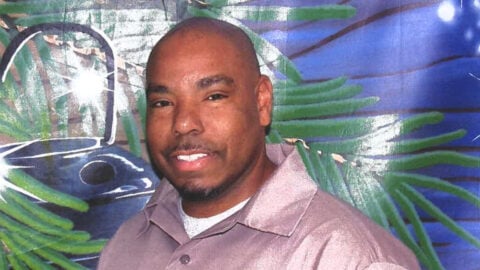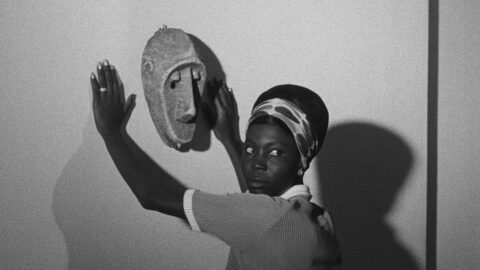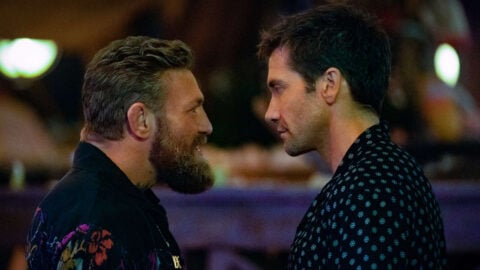Art of the Real: Edvard Munch by Peter Watkins

Like the work of the artist whose life and times it evokes, Peter Watkins’s 1974 film Edvard Munch comes off as a thing of frayed nerves, passionate resentments, and stray sexual frustrations, made on what feels like the edge of delirium and out of what seems like a desperate need to confess or exhume. The truth of the matter, in the case of Edvard Munch’s paintings and Watkins’s movie, is more complicated than that description suggests.
In the second half of his life, Munch (1863-1944) reminded anyone with a mind to read his diaries—of which Watkins’s film makes much use—that
when I write these notes, it is not to describe my own life. I am writing a study of the soul as I observe myself closely and use myself as an anatomical testing-ground. It would therefore be wrong to look at these notes as confessions. I have chosen—in accordance with Søren Kierkegaard—to split the work into two parts: the painter and his distraught friend the poet. Just as Leonardo da Vinci studied the recesses of the body and dissected human cadavers, I try from self-scrutiny to dissect what is universal in the soul.
What Munch says of his diaries could be applied just as well to the many pictures he produced between the early 1880s, when he was nearing the end of his teens, and his death in 1943. It’s at once one of the main limitations of Watkins’s excavation of the Norwegian painter’s inner life and a primary source of its emotional power that it concentrates on Munch’s unstable, passionate temper at the expense of his fierce intelligence and, no less importantly, on his gift at poetic self-mythologizing. You would hardly guess watching Edvard Munch that the artist was, in fact, an avid reader of high-level mathematical treatises, nor that he was strikingly savvy about courting the public attention he sometimes claimed to resent.

Coming between his 1964 debut feature Culloden and his most recent full-length film to date, 2000’s La Commune (Paris, 1871), Edvard Munch remains one of Watkins’s most ambitious attempts to film pre-cinematic history using the methods—and the ethics—of modern documentary reportage. One of the British director’s most relied-upon moves in the film is to open a shot from wobbly mid-distance—he shot the movie on grainy 16mm using a handheld camera—and zoom rapidly into a tight close-up after a second’s pause, like a fly-on-the-wall videographer zeroing impulsively in on a revealing bit of evidence. It’s hard to remember a period film with fewer establishing shots than this, or, for that matter, any sorts of attempts at prefatory scene-setting.
What we see instead, watching the film, is an unbroken, chronologically shuffled three-hour stream—the version Watkins prepared for television was closer to four—of brief, lacerating, confrontational close-ups, many cued to start and end midway through a single camera movement, most designed to collide violently and jarringly with the shots in their orbit. A handful of images draw on events from Munch’s childhood and adolescence: the deaths of his mother and sister from consumption, his own bout with the disease at 13, his early, traumatic love affair with a married woman he refers to in his writings only as “Mrs. Heiberg.” These punctuate the movie’s telling of the artist’s life, which veers back and forth between his youth and his mature career before stopping, somewhat abruptly, at the dawn of the 20th century.
What we hear watching the movie is a multilayered collage of environmental sound, dance hall numbers, plaintive piano music, violin sonatas, choral readings from Munch’s diaries, and, above it all, Watkins’s dispassionate voice giving a biographical account of the painter’s life and career that wouldn’t feel out of place in any number of made-for-TV documentaries. From time to time, the movie pauses for a direct-to-camera interview—the sort reserved, in those TV documentaries, for experts and scholars—with an actor playing one of Munch’s friends, lovers, colleagues, or critics.

One way to take Watkins’s stylistic habits—rifling from shot to shot; using zooms and sudden pans to pull the rug out from individual images; piling on sonic elements of vastly contrasting registers and tones—is as approximations of the effect Munch wanted his own pictures to have. “One sees things at different moments with different eyes,” the artist wrote in his journal in 1890:
Coming in from a dark bedroom in the morning into the sitting room one will, for example, see everything in a bluish light . . . If the atmosphere of this kind is being painted, it won’t do merely to sit and gaze at everything “just as one sees it.” One must paint precisely the fleeting moment of significance—one must capture the exact experience separating that significant moment from the next—the exact moment when the motif struck one.
It is as an attempt to find a cinematic vocabulary with which to “paint the fleeting moment of significance” that Edvard Munch arrives at its most staggering effects. When Watkins is at his best, few other filmmakers could shoot a historical re-enactment with such attention to what it would have been like to be there in a particular studio, bedroom, café, or bar, struck by a particular barrage of smells, proximities, blushes, emanations, fragments of music, and casts of light.

Would Watkins have been satisfied doing only this sort of work? There’s an expectation running through the movie that the stream of mental data we see when we watch an artist’s imagination at work will give an explanatory account of why, exactly, the man in question painted what he did. The adult Munch, played by Geir Westby, is, as shown here, haplessly buffeted in his mental life between images that correspond (somewhat crudely) to the terrors of sex and images that suggest (no less crudely) those of death: a shot of a gob of thick red paint emerging from a tube gives way to a familiar image of young Edvard keeled over in bed on Christmas morning coughing up blood; a scene of the mature artist painting The Vampire comes intercut with repeated glimpses of “Mrs. Heiberg” (Gro Fraas) fixing a druggy kiss on the younger Munch’s neck. With these attempts to account for what we see in the paintings themselves by appealing to what we know—or think we know—of the painter’s life, the movie, it seems to me, goes off-track.
Edvard Munch was born in 1863 to a devoutly Pietist doctor and his much younger wife, who bore the older man five children before her death from consumption five years after Munch’s birth. His was a fairly grim childhood; the family lived on the brink of poverty, often having to scour the house for loose coins to cobble together money for the rent. In 1977, Edvard’s sister Sophie, with whom he had the closest of his boyhood relationships, died at 15 of the same disease that had killed her mother. It was the start of a long history of unhappiness and mental illness among the Munchs. His younger sister Laura would eventually be institutionalized for schizophrenia, and his brother Andreas, the only one of the siblings to marry, died young and, by his own account, miserable. In Edvard Munch, the siblings’ father, Christian, comes off as unbendingly moralistic and stern. In fact, he was occasionally garrulous and playful, but more often it was weakness, rather than hardness, that defined him in Edvard’s eyes. A doctor, he was said to go pale at the sight of blood.
Munch returned incessantly to images from his early childhood in his art. When he was very young, the family moved to Kristiania (now Oslo), where a cultural revolution was just starting to develop. In his late teens, Munch fell in with a circle of radicals based out of the capital and centered on Hans Jaeger, a publicity-hungry anarchist to whom Munch would later credit his choice to repudiate the religious tradition in which he had grown up. It was in Kristiania that Munch would develop his lifelong acquaintanceship with the painter Christian Krohg and his wife Oda, and there he met, and lost, Mille Thaulow—the “Mrs. Heiberg” to which his diaries keep returning. (Munch’s other most influential relationship during this period was most likely with Aase Carlson, a fellow artist with whom the painter developed a close platonic bond after the collapse of his affair with Thaulow. Carlson’s wedding, which Munch attended clandestinely and, it’s often speculated, with regret over a missed opportunity, has a prominent place in Edvard Munch.)

In 1886, Munch succeeded, with some much-needed lobbying from Krogh, in persuading the jury of the newly created Autumn Exhibition to show his painting The Sick Child, an agonized canvas inspired by Sophie’s death and covered with scores, cuts, scratches, and blacked-out elisions by the time Munch left it for done. The painting, as Watkins’s film declares insistently, appalled the local press—as did the solo show the 25-year-old Munch held in 1889. Munch left soon after for a transformative period of study in Paris under Léon Bonnat, during which he learned from afar about his father’s death, but his art only received serious attention once he had traded his circle of Kristiania bohemians for the community of artists, writers, scientists, philosophers, and occultists then simmering in fin de siècle Berlin.
In many of the best passages in Edvard Munch, Watkins’s camera twists and glides desirously around Zum Schwarzen Ferkel (“The Black Piglet”), the wine club where Munch first became entangled with, among others, Stachu Przybyszewski and August Strindberg. Here too he met Dagny Juel, with whom he had a brief, artistically productive affair—she posed for, among other pictures, his Madonna—before she fell into what would be a tumultuous marriage to Stachu. Juel was a disruptive presence in the all-male Ferkel crowd, and though Munch, like the rest of its members, could be too quick to relegate her to the status of a temptress or a muse (“all she had to do,” he wrote of her, “was look at a man, place her hand on his arm, and immediately he found the proper expression for something over which he had been brooding helplessly”), the two of them stayed on good terms. Munch wrote her one of her few truly admiring obituaries when, in 1901, she was shot dead in Tbilisi by a disgruntled lover, and Watkins does her equal justice; it’s she (as played by Iselin von Hanno Bast) who, in her direct-to-camera interviews, gives the movie some of its most levelheaded insights into the business of romantic love.
The Munch on which the movie focuses, it’s important to say here, is the persona the painter took on as a young man, and from which he drifted away as the new century went on. We see nothing, in Edvard Munch, of the artist’s tumultuous cross-continental affair with Tulla Larsen (the couple fought, separated, and re-united incessantly until Munch took a gunshot wound to the hand during one of their quarrels); his decision to commit himself to psychiatric care; his subsequent retreat to a cottage in Åsgårdstrand; the muted, intensely private, possibly platonic relationships he maintained later in life with a succession of live-in models; or the two decades he spent watching the Nazis come to power. (“His works speak to me,” read a gushing third-person birthday letter Munch received in 1933, “of life’s profound seriousness… A powerful, independent strong-willed spirit-heir of Nordic culture, he frees himself from all of naturalism and returns to the eternal foundations of National art-creating.” The letter was from Joseph Goebbels, whose admiration for Munch’s paintings did not keep them from being labeled “decadent art” under Hitler.)

If it is no accident that Edvard Munch stops where the 19th century ends, it’s perhaps because the young Munch—passionate, tortured, vigorous—is particularly adaptable to the picture of artistic genius in which Watkins is invested. This is a Munch for whom sex is a debased, contested, and endlessly agonized-over need, a Munch who keeps long, brooding, downcast silences in the most boisterous company, and a Munch for whom it is possible to say of Mille Thaulow, as he does in the movie’s last lines, that “I felt as if there were invisible threads of her hair still twisting themselves around me.” Many of the lines attributed to Munch in the movie are drawn directly from the artist’s journals from the period: feverish jottings on solitude and loss, written in an elaborately poetic style.
Watkins is careful to insist on the extent to which this Munch was a product of his unusually dense, richly textured epoch. The contrast between the breezy lifestyle of Norway’s turn-of the-century upper classes, who take strolls down Kristiania’s central boulevard every afternoon, and the squalid conditions in which the country’s working poor lived; the particular brew of Satanism, Freudianism, Nietzscheism, anarchism and nihilism that emerged among the literati in Europe’s major cities around that time; the revolution in sexual mores that took place on the continent as the nineteenth century gave way to the twentieth—Edvard Munch is remarkably clear-eyed about the manifold conditions under which Munch’s art developed. It’s all the more surprising, then, that Watkins refuses to acknowledge what Jay A. Clarke astutely points out in his book Becoming Edvard Munch: that Munch’s persona as a tortured, sexually haunted young genius was as much a deliberate, artful creation as were his paintings.
Munch had a special gift for engineering scandal. It takes a particularly brazen temperament, or a precocious skill for self-mythologizing, to give yourself the first-ever solo show in your country’s history at age 25, and to include in that show—for which you are charging a fee at the door—everything you have ever made. It likewise takes a certain kind of ambition to document one’s traumas in the specific way Munch, in his diaries, documented his: poeticized, stylized, often written in the form of third-person dialogue scenes between pseudonymous parties. (“Fru Heiberg placed herself before the piano / Brandt sat in the corner—by the stove and / watched her—while she sang he followed / one soft inclination of her back…”) Munch’s early career was an odd mixture of feverish, generative artistic activity and savvy self-marketing. In that second capacity, the artist’s friends, colleagues, and rivals also played a part; the collection of four essays Przybyszewski edited on Munch in 1894, written by essayists from Strindberg’s school eager to claim the painter as one of their bohemian own, played a large part in creating his international persona.

You could call what we witness in Edvard Munch a record—or a product—of a different sort of seduction from the kind to which Munch claimed to have fallen victim with Mille Thaulow. The movie is visibly intoxicated by the persona Munch gave himself, often to the exclusion of recognizing that persona as the construction of, in Munch’s words, “the distraught [painter’s] friend the poet.” It buys perhaps too readily into the lofty, slightly inscrutable goals Munch set for his own art, whether those were—as Munch put it—“to dissect what is universal in the soul” or, as the movie’s narrator characterizes the aim of the great “Frieze of Life” series Munch painted in Berlin, “to unfold the very meaning of nature and existence.”
On the other hand, you could argue, it is precisely the movie’s refusal to interrogate Munch too deeply that motivates it to attend to his pictures with the passionate focus that it does. Look, for instance, at how Watkins re-stages the making of the works themselves, keeping a tight lock on the character’s hand as it chisels away at the surface of a woodcut, or slathering the soundtrack with what sounds like microphone static whenever the artist scores deep enough into a canvas. It’s worth watching the attention the camera gives in those scenes to the material out of which Munch worked, or to the physical business of thickening, thinning, layering, or violently scraping away at paint on a surface—just as it’s worth listening, throughout the movie, for the thrilling ways in which Watkins uses snippets of music or voice recordings to give each image precisely the additional sort of texture it needed. “It may even be,” Christian Krohg wrote about Munch’s work around the time of the latter artist’s move to Berlin, “that [his craft] is related most closely to music and not to painting, but in any case it is brilliant music.” It may be that Edvard Munch is, in any case, something like brilliant cinema—but to say that is to say that it succeeds more fully as a musical composition than as a picture of what it looked like for Munch to live a life in art.
Edvard Munch screens April 12 in Art of the Real at the Film Society of Lincoln Center. For many of the quotes and biographical details used in this essay, the author is indebted to Sue Prideaux’s Munch biography Behind the Scream (Yale University Press, 2007).







